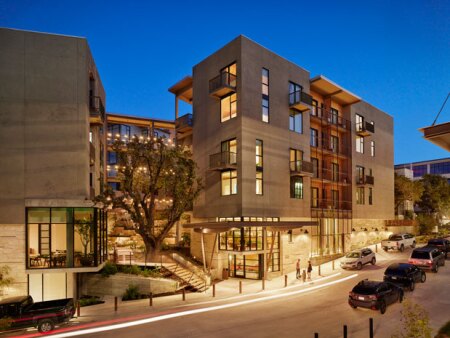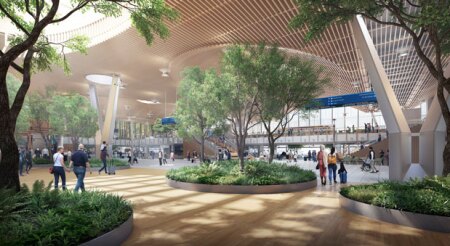
Opened in 2020, Hotel Magdalena in Austin, Texas, is the first mass timber boutique hotel in North America. Designed by Lake|Flato Architects for local hospitality management organization Bunkhouse Group, the building reveals its wood structure, referencing the design of ranch houses in the Texas Hill Country. (Photo courtesy of Casey Dunn)
Mass timber has come a long way in the United States in the past eight years.
“It wasn’t really in the building code in the United States until 2015,” says Bill Parsons, vice president of operations at WoodWorks, a nonprofit organization and a ULI Greenprint innovation partner headquartered in Washington, D.C. “Since then, we’ve gone from a handful of projects to over 1,300 mass timber projects that are in design or have been built in the United States. People are making money doing this—they try it once on a smaller project and then move to a bigger project. That’s the trend we’re seeing.”
Typically consisting of panels, columns, and beams of engineered wood products, mass timber structures are more lightweight than either concrete or steel ones and exhibit high levels of fire resistance. At a time when construction companies are experiencing labor shortages and supply chain issues have hiked material costs, mass timber holds the promise of requiring smaller construction crews and perhaps less price fluctuation compared with its conventional counterparts, steel and concrete. A renewable resource, it also sequesters carbon. However, fulfilling mass timber’s green potential means ensuring responsible forest management and planning for what happens to the timber after the building’s end of life.
Competing on Price and Lowering Labor Costs
Lumber costs have been particularly volatile since the start of the pandemic, increasing more than 300 percent between April 2020 and May 2021. However, those costs have been falling in recent months. “On a current project we’re pricing, we’re finding mass timber is coming in cheaper than steel and actually being quicker to source,” says Chris Chatto, principal of ZGF in Portland, Oregon. “We see the mass timber industry growing, and there’s going to be more competition and sophistication in the markets in terms of efficiencies.”
Because mass timber components are manufactured off site in factories, smaller construction crews are required on site, and construction can be quicker. “In areas with potential labor shortages, because of the prefabricated system and because so much of the coordination of the trades is done ahead of time, you can train less experienced labor in some of the trades to work with mass timber,” says Melissa Kroskey, technical director at WoodWorks.
Drawing on building information modeling enables precise detailing of timber components. “Our first mass timber building had over 4,200 penetrations for mechanical, electrical, and plumbing systems, which we did as part of the manufacturing process,” says William Silva, director of preconstruction at Swinerton, Portland, Oregon. “None of that had to be done on site: we didn’t have to try to core through a beam to run a pipe through it. The holes are there, all you have to do is run the pipe.”
For example, Swinerton only needed seven carpenters in the field to construct the 156,000-square-foot (15,000 sq m) First Tech Federal Credit Union building in Hillsboro, Oregon. “We were able to fabricate more in the factory, and so that provided living wage factory jobs,” Silva says. “We’re finding that mass timber can allow for a safer environment for our workforce.”
Navigating Supply Chain Challenges and Volatility
The pandemic has disrupted supply chains across the globe, and uncertainty seems part of the new normal. “All building materials right now are experiencing escalation,” says Silva. “We’re seeing pretty heavy pricing volatility not just in wood but also in steel and PVC and all kinds of goods.”
The pandemic is not the only disruptive force, either. “There are so many things going on right now in the market, beyond just the volatility of lumber price,” says Michael Britt, associate at Lake|Flato in San Antonio, Texas. “In Texas, right after Hurricane Harvey, it was impossible to get a gypsum board subcontractor, and the cost of concrete was really high.”
Depending on circumstances, the design team may have to change course and fall back on an alternative material if prices skyrocket. “It’s pretty easy to pivot from wood to concrete or steel, but it’s not easy to pivot back the other way, because of the spanning requirements and all these other things,” Britt says. “So we always have to remain flexible and talk with our clients about alternative solutions.”

Designed by ZGF, the new main terminal for the Portland International Airport in Oregon will have twice the square footage as its predecessor and feature a 380,000-square-foot (35,000 sq m) mass timber roof, using wood from landowners and mills within a 600-mile radius. (Rendering courtesy of Port of Portland)
Silva notes that contractors can work with mass timber manufactures to mitigate volatility. “We take an approach towards addressing specific resource constraints within the supply chain,” he says. “By doing that, we’re able to create more flexibility. We partner with them to understand their manufacturing cycle.”
In addition, different manufacturers have different relationships to the lumber that they procure.
“Some of the mass timber manufacturers are vertically integrated, so they’re not really at the whim of market forces for commodity lumber,” says Parsons. “They’re actually harvesting their own trees and making the laminated stock that goes into the product. So their pricing is much flatter and much more stable than what you might see elsewhere.”
At least one real estate developer has taken the unusual step of acquiring its own forests. The Atlanta office of real estate investment and management company Jamestown is adding a mass timber office building to its mixed-use center Ponce City Market in Atlanta. “We’ve really focused on pushing sort of the supply chain, which is traditionally from the Pacific Northwest or from Europe, into locally sourced Southern Yellow Pine, and we also own timber forests,” says Michael Phillips, Jamestown’s principal and president. “Our goal is to use our timber from our forests to help move the industry forward by having cross-laminated timber plants built in the Southeast, and to create efficiencies through the whole supply chain.” Jamestown is partnering with Georgia Pacific, headquartered in Atlanta, on the effort.
Realizing Mass Timber’s Green Promise
If a large part of mass timber’s appeal is its potential as a renewable resource that sequesters carbon, then it is essential that owners and occupants feel secure that the green benefit is real across the building’s life cycle. If the wood ends up in a landfill at the end of the building’s life, its carbon will be released back into the atmosphere. Designed by local firm William McDonough + Partners and currently under construction, the Apex Clean Energy headquarters in Charlottesville, Virginia, is designed to be deconstructed at the end of its life, Kroskey notes. “Mass timber’s large panels are easy to reuse, depending on how they are connected,” she says. “There is a lot of potential to reduce waste.”
Similarly, poor forest management can diminish biodiversity and ecosystems. ZGF is taking steps to become familiar with manufacturers’ lumber sources and track those sources with particular accuracy, even once the building is erected. “We’re trying to navigate the supply chain and be able to point and say, ‘This beam in our building came from this forest, and we visited that forest, we know the sustainable harvesting techniques that they’re using,’” says Jacob Dunn, associate principal at ZGF. “So we can actually connect the dots—it’s called ‘forest to frame,’ like the mass timber version of ‘farm to table.’ Clients have been really interested in that.”
For example, for the new main terminal for the Portland International Airport, ZGF designed a curvy mass timber roof. “We know where 100 percent of that wood came from,” Dunn says. “We’ve linked it back to nine different landowners in Washington and Oregon that provided the wood, and we’ve toured those forests. They’re all owned by small family landowners or nonprofits, or they are tribal or community forests. We know how they’re managing them.”
Mass Timber as Differentiator
The desire to respect and connect with nature dovetails with another rising trend: biophilic design, which aims to bring natural elements into the built environment. When the architects at KTGY were designing the Edes Building, a two-story art gallery and wine bar now under construction in downtown Morgan Hill, California, they explored choosing mass timber for its look, along with its ability to provide longer spans than standard wood.
“Knowing the space was going to be an art gallery, we wanted to expose the structure,” says Sean Martino, associate principal in KTGY’s Los Angeles office. “That gave us a nice, cool, rich feeling. We were making an art gallery, but we’re also making a building that’s somewhat of a sculpture. We weren’t thinking of the economic aspect at that point. But we realized later that, although there was a price premium for this material, at the same time, we wouldn’t have to think about how we were going to treat it or cover it up.”
Exposed wood interiors also differentiate properties from conventional counterparts. For 1 De Haro in San Francisco, a three-story Class A office building designed by the local office of Perkins & Will and profiled as one of WoodWorks’s case studies of successful mass timber projects, the owner, SKS Partners of San Francisco, found that poor soils posed a challenge for a heavy concrete building. “They initially looked at mass timber as a lightweight structural solution,” says Kroskey. “The more they learned about mass timber, they realized it also has an aesthetic appeal if you leave it exposed. That really appealed to the ESG-driven tenants in that area.” The office building was leased up early during construction, with multiple backup offers, she says. “We’ve seen a lot of developers benefit from mass timber, not necessarily from leasing premiums, but from leasing velocity.”
Parsons also sees mass timber as a differentiator for commercial property owners. “Right now, we definitely have a pause on office construction, but people are going to build offices. There needs to be a different type of office. When they go back, people want to be in a cool place, they want to be in a place that’s healthy and makes them feel good.”
“A lot of our clients, especially in the Pacific Northwest, are excited about being part of the mass timber movement,” says Dunn. “Lumber is in our blood, it’s part of the region’s history. And our institutional, higher education, tech, and even health-care clients want to connect with the communities they serve and are interested in the idea of what it means use local resources.”
RON NYREN is a freelance architecture, urban planning, and real estate writer based in the San Francisco Bay area.








